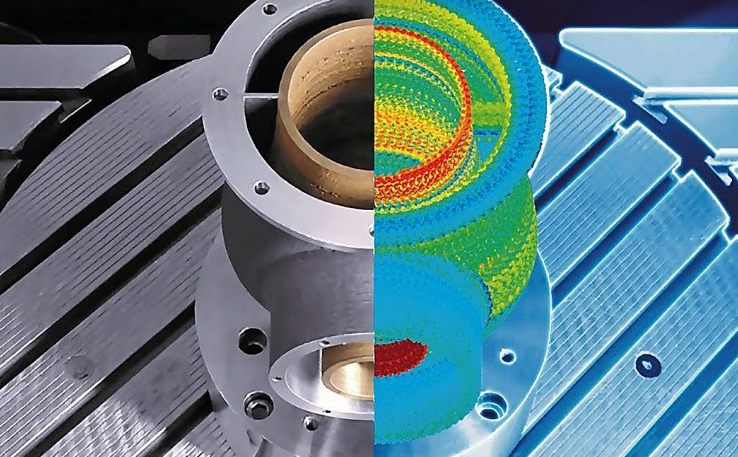DMG Mori has just released the Lasertec 125, a 3D hybrid that creates, maintains, and repairs workpieces up to 1,250 mm wide x 745 mm high, weighing up to 2,000 kg. The five-axis center offers additive manufacturing processes as well as integrated laser deposition welding capability.
The Lasertec 125 3D hybrid offers:
- Better accuracy
- Reliability
- Affordability
- Production of complex components in one print
This new DMG Mori technology was originally launched as the LASERTEC 65 3D hybrid, a smaller model. The line was then expanded to include the LASERTEC 4300 3D hybrid, offering users formidable choices—with AM and powder nozzle technology in one work area, and powder bed machines in the LASERTEC SLM series.
While 3D printing originally emerged as a miraculous technology for creating prototypes and products faster and more affordably, and often with the ability to make items not before possible, letting go of conventional methods has not been quite that easy—and often not for the best when it comes to specific production; however, with hybrid manufacturing, industrial users have it all.
In a recent press release sent to 3DPrint.com, the DMG Mori team explains further that due to the monoBLOCK platform, this hybrid system offers users the ability to manufacture products quickly, enjoying ‘high dynamics’ and superior repeatability.
Stating that ‘automatic changeover between laser deposition welding and simultaneous 5-axis milling in a single set-up reduces processing times by up to 80 per cent,’ the DMG Mori team points out too that without heat treatment required as a separate step, their customers experience another one of the greatest benefits of 3D printing and additive manufacturing: greater savings on the bottom line during production.
Other impressive features include:
- Simultaneous five-axis milling (and the use of laser deposition welding
- Production and repair of hot and cold forming and forging dies (for fabrication of closed impellers, as an example)
- Ability to reduce weight of parts by 90 percent
- Multi-material production, switching between materials with CNC
“So, for instance, hard surfacing to reduce wear can be carried out in one area and corrosion-resistant welding for environmental protection may be carried out in another. Alternatively, the cooling characteristics of a part can be significantly increased. As an illustration, a die casting mold can be produced by starting with a bronze core that dissipates heat effectively and welding onto it an outer skin of tool steel,” states DMG Mori.
Offering an improved method for repairing and recoating, industrial users can use the DMG Mori system for milling, repairing via the laser deposition welding feature, and milling again at the end as the part is finished.
“Due to precise process control, the weld material deposited is of very high quality. The service life of repaired inserts for a die casting mold, for example, is three times longer than if it had been repaired by manual welding,” states DMG Mori.
This platform is useful especially in atmospheres where plants or factories may need priority, and reduced maintenance times are extremely helpful—with applications like oil and gas, chemical, and pharmaceutical.

Multi-material applications and graded materials can be realized with DMG Mori’s LASERTEC 3D hybrid machines.
The LASERTEC 125 3D hybrid also offers intelligent, high-performing hybrid CAM software. The powder nozzle technology was actually developed for DMG Mori by Siemens NX, providing end-to-end repair programming—switching back and forth between machining and laser deposition welding. AM Assistant also includes a camera for constant monitoring of:
- The entire part or specific areas
- Melt pool size
- Temperature
- Clearance between nozzle and component
AM Evaluator stores 3D data regarding the melt pool, powder flow, and laser flow—allowing for easy analysis by the industrial user, with QA reports generated automatically.
Hybrid systems continue to be popular with industrial users, with NASA using hybrid 3D printing to make rockets, Siemens developing robotic arms, and a variety of different opportunities emerging for AM and CNC companies.
What do you think of this news? Let us know your thoughts! Join the discussion of this and other 3D printing topics at 3DPrintBoard.com.
[Source / Images: DMG Mori]Subscribe to Our Email Newsletter
Stay up-to-date on all the latest news from the 3D printing industry and receive information and offers from third party vendors.
You May Also Like
3D Printing Webinar and Event Roundup: April 7, 2024
Webinars and events in the 3D printing industry are picking back up this week! Sea-Air-Space is coming to Maryland, and SAE International is sponsoring a 3D Systems webinar about 3D...
Roboze Brings Performance Polymer 3D Printing to SoCal via New Partnership
High-performance polymer 3D printing firm Roboze has been steadily working to expand its global footprint, with a firm eye on distributed manufacturing, particularly with regard to the oil and gas,...
3D Printing Webinar and Event Roundup: March 3, 2024
In this week’s roundup, we have a lot of events taking place, including SPE’s ANTEC 2024, Futurebuild, the AAOP Annual Meeting, JEC World, and more. Stratasys continues its training courses,...
Advanced Manufacturing Firm Zeda Acquires The Orthopedic Implant Company
Zeda, the San Francisco-based provider of advanced manufacturing solutions, announced that it has acquired The Orthopedic Implant Company (OIC), a medical device manufacturer based in Reno, Nevada, for an undisclosed...

































